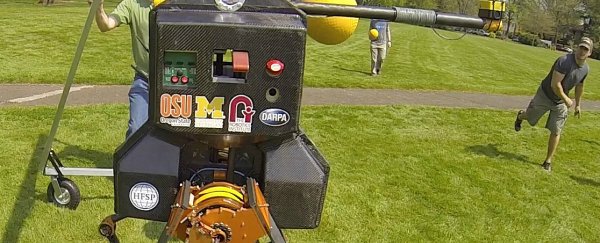Meet ATRIAS, a bipedal robot that's been designed to walk just like a human. And as you can see in its first outdoor test above, it does a better job of it than most humans we know, maintaining a pace of 4.8km (3 miles) per hour while navigating uneven terrain, and even having balls being thrown at it.
Developed by engineers at Oregon State University in the US, ATRIAS is being heralded as the running robot of the future, and is the closest researchers have come to being able to mimic the elastic, energy retention ability of human locomotion. Because of this, the robot requires substantially less power than other robots - its six electric motors are powered by a battery around the size of a 2-litre container of milk.
"Animals with legs sort of flow in the energy used, in which retained kinetic energy is just nudged by very efficient muscles and tendons to continue the movement once it has begun," said mechanical engineer Jonathan Hurst in a press release.
"That's part of what's unique about ATRIAS - not just that it can walk, and will eventually run - but that it's doing so with animal-inspired fluidity of motion that is so efficient," he added. "This will ultimately allow a much wider range of robotic uses and potential than something which requires larger amounts of energy."
For its outdoors trial, which ATRIAS got pretty excited about over on Twitter, the robot was attached to a safety harness that rolled along with it in order to catch it if it fell, which it did a couple of times due to sensor glitches. However, the test was able to successfully show that ATRIAS used far less energy than other bipedal robots its size.
I walked outside for the very first time. #Robots don't get emotional about these things, though... *sniff*#Robotics http://t.co/FRGAtGKWkb
— Dynamic Robotics and AI Laboratory (@osudrl) April 27, 2015
"It already appears that ATRIAS is three times more energy-efficient than any other human-sized bipedal robots," said another engineer on the project, Christian Hubicki. "And this was the first time we've been able to show its abilities outside, in a far more challenging environment than anything in a laboratory."
A crucial part of ATRIAS' development is working out how baby humans, and other animals, input all the sensory information that they get from their environment, and use that to coordinate their locomotion - something that the robot's engineers are still trying to master. But they've already shown that, not only can ATRIAS stay upright on grass, but that they can kick the robot and it'll just keep on keeping on.
This isn't the first team to test their robot's stability by kicking it - and we've already warned engineers against this in the past - because if artificial intelligence does take over the world, as Stephen Hawking has predicted, we're pretty sure they're going to remember all the trials we put them through. But other models that display similar stability usually have four legs, and move more like dogs or cats.
While the long-term goal for ATRIAS is to become a stable, running robot, in the short-term, the team hopes that their research could be used to help build better prosthetic limbs, or exoskeletons that can help people regain control over their legs.
Those are all noble goals, but how about we limit the ball-throwing for now, for the sake of future robot-human relations?
